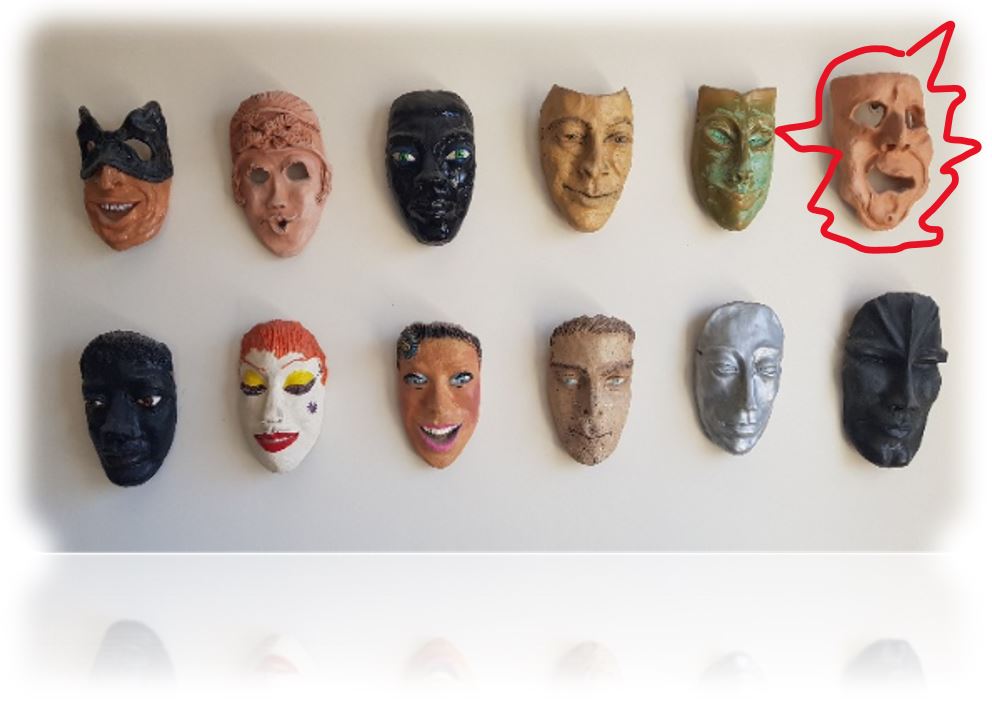Conversation 43: What is common between communication with the other and the board of internalized figures?
Greetings,
Let us first mention again that in the model we propose for the "self", one must first differentiate between the primary self, which is actually the basic biological nucleus consisting of several innate structures and which is subject to development during life. and the "social self" [consisting of "secondary selves"], which is a structure that develops during a person's exposure to social influence, and consists of internalizations of figures significant to a person, originating either from external groups or from imaginary groups (related, for example, in the form of a story, from a myth, from a movie, etc.) that were having a considerable effect on the person). The "secondary selves" included in the "social self" include 1] the variety of representations of the "Me" that originate from attitudes and feelings towards the self and its representations in different periods of life 2] the representations of internalized figures that often originate from significant figures that the person is exposed to during his life but as mentioned may also be imaginary characters represented in books, films, etc. that have had a considerable influence on man. 3] internalized representations of the "subculture" [subculture refers to social influences in the milieu [environment] in which the person lives and are not necessarily related to a specific person].

The board of characters and the internal dictator: Photograph in courtesy of Shimshoni Sarit
We call the social self metaphorically the "directorate of characters" or more specifically the "directorate of internalized characters." We note that, as we mentioned before, in this board there is usually a hierarchy in which there are more influential and dominant figures that we metaphorically called "the tyrant or internal tyrants" and these set the tone and even censor what content, attitudes and behaviors cannot be contained in the board of figures.
We note that the person as a whole is not aware of the influence of the board of characters and recognizes the influence as coming from himself and his own will and positions. We will also note that, as a rule, the board of directors is very dynamic and there are constant struggles and power relations between the internalized characters that make it up on the positions that will be expressed when the internal dictator or dictators dictate the tone.
We will now ask what happens in communication between two people in general and between spouses in particular?
First, the model provides a new understanding of the communication processes between people. It shows that communication is not only the transfer of information between people, but also a process of interaction between the "board of characters" of the two parties involved in the conversation.
For example, a woman whose directorate of internalized figures includes the figure of her dominant mother may feel the need to control her partner and demand her consent to every decision. In such a case, communication between the couple may be tense and full of power struggles. Conversely, a man whose character directory includes the figure of his loving and supportive mother and father may feel secure in his relationship with his partner. In such a case, there is a chance that the communication between the couple may be open, honest, and full of trust. Of course, communication also depends on the board of directors of the other party.
Secondly, when we talk about the effects of the board of internalized figures, it is useful to take into account:
The scope of the impact:
The more important and dominant characters on the character board may have more influence on the communication. All the more influential characters and especially the inner dictator may set the general tone of his communication.
Sources of influence:
It is possible that internalized figures that are more important than the figure closest to the person will have a greater influence on their relationships with spouses and with certain people.
Type of influence on the emotional models and behavior:
The internalized characters can influence the emotional expressions of the person and determine his ways of behaving.
The development of the social self:
The internalized figures can influence the development of the social self of the person, including getting closer to social groups or subcultures that have significant figures.
Worldview:
Certain characters from the board may point to a certain worldview, thus influencing interpersonal communication and its various aspects.
In general, the board of internalized characters can affect both communication and relationships between spouses and between people as well as their personal and social development. A conscious understanding of these effects can enable improved relationships and communication and promote positive personal and social development processes.
Thirdly, we emphasize that in communication the main problem stems from a difference of internalized characters between the two communicators – the more different the attitudes and characteristics of the dominant characters [especially the inner dictator] and the other internalized characters, the more complicated and complex the communication and vice versa.
We assume that this is one of the causes of the growing "resemblance" between spouses who are characterized by a good relationship and doing things together – since over the years they have more and more internalized figures in common.
As a rule, the "board of characters" of two people communicating with each other, including spouses, affects their communication in a variety of ways, including:
• The way they perceive each other: The introverted characters of the couple can affect the way they perceive each other. For example, if one person's character directorate includes the image of their dominant mother, they may see their partner as weak and dependent.
• Their relationship: the internalized characters of the couple can also affect their relationship. For example, if one person's character board includes the figure of their loving and supportive mother, they may feel safe and secure in their relationship with their partner.
• The communication between them: the internalized characters of the couple can also affect the communication between them. For example, if one person in his character board includes the image of his dominating mother, he may speak to his partner in an unequivocal and unbalanced way, while one person in his character board includes the image of his sensitive mother, he may speak to his partner in a sensitive and thoughtful way.
Below are several examples of the influence of the "board of characters" on communication between spouses:
Example A:
A man named Yoni grew up in a home with a domineering single mother. She was responsible for all decisions in the family, and he always felt the need to get her approval. Today, Yoni is married to a woman named Adi. Yoni often finds himself trying to control Adi and her decisions, just as his mother controlled him. Adi feels crushed by Yoni, and they often fight.
Example B:
A woman named Michal grew up at home with a loving and supportive mother. Her mother was always there for her, and she always felt loved and protected. Today, Michal is married to a man named Oren. Michal feels comfortable with Oren, and she can talk to him about anything. They communicate with each other openly and honestly, and they share a strong bond.
If so, awareness of the "character board" can help people communicate more effectively and meaningfully with others.
Fourthly, improvement in communication can be carried out in two ways at the same time – first, bringing the communicator to understand his own internalized characters and their influence on his attitudes and behavior, and on the other hand – increasing his ability to analyze and understand the internalized characters in the communication partner or spouse, etc.
For example, people who wish to improve communication with their partner can try to understand their partner's "directorate of characters". They can do this by talking to their partner about the significant figures in his life, and how these figures affect him. In addition, we will emphasize that people who wish to improve communication with others should be more aware of their "character board". They can do this by trying to identify the characters that make up their "character board," and how those characters affect them. In other words, awareness of the "character board" can help people communicate more effectively and meaningfully with others.
We will try to summarize it as follows:
People who want to improve communication with their partner can try the following:
• Try to understand your partner's "character board": Do this by talking to your partner about the significant figures in his life, and how these figures affect him. Clues to how the characters influence the other can also be obtained from reviewing his reactions in different situations in the past and of course from his main positions which sometimes reflect the positions of his internalized inner dictator.
• Become more aware of your "character board":
Do this by trying to identify the characters that make up your "character board," and how those characters affect you.
• Also talk to relatives and friends who have accompanied you for years, aware of your history and the figures who influenced you.
• Awareness of the above and openness to accept the fact of the fundamental difference of the other [actually to our assumption of the difference of the internalized board of directors] are essential for improving communication. It should also be remembered that in order to understand the other person, it is important to get to know his internalized characters as he internalized them and not according to their objective characteristics in external reality.
• Be open and respectful towards your partner's internal characters: remember that these characters are an important part of your partner's identity and make up his social self.
• After understanding the difference in internalized boards, be prepared to compromise: Remember that you both need to work together to create good communication.

Communication between spouses
Fifth, the example of identical twins emphasizes how the influence of the internalized figures works – on the one hand, they usually have similar internalized influential figures especially at the beginning of life [common parents and siblings] and communication is easy and fluent, but later on when their paths diverge, they are exposed to different influences during life and the internalization of different and not identical figures and this can make communication between them more complicate. Similarly, partner problems often arise as a result of each of them being exposed during the relationship to different sources of influence and thus the internalized group of referred figures [the board of directors] becomes less and less similar over the years.
Sixth, by the way, the things mentioned above are also true for a group of people. For example, if the members of a group of people are mostly characterized by a similar "internalized character board", they may find themselves communicating relatively easily with each other.
On the other hand, if a group of people includes a significant number of people with very different "character boards", they may find themselves having difficulty communicating with each other. We note that similar rules apply to large cultural groups and even to countries, since the communication between them is conducted through their leaders, each of whom is characterized by a different board of internalized figures, and in addition, we emphasize that each group or country has a consensual figure of the subculture that will greatly influence the communication with the other side.
And a final note, it seems that a continuous marital relationship consists of two stages: a. A relatively short initial phase, the falling in love phase, here the character of the partner can neutralize the internalized inner dictator, and in any case occupy a high place in the internal hierarchy in the board of internalized characters. In the second stage as the appeal declines, the board group undergoes reorganization, and the previously dominant figures increase in importance.
Finally, we believe that our theoretical concept explains, among other things, two phenomena related to psychological treatment, but they may also be important in communication between two people, including spouses. One of them is “mirroring” as a technique that promotes empathy and transparency, the other one is “transference” that allows the identification of the ways of the inner dictator or other most influential figures in the internal board hierarchy.
A] Mirroring
MIRRORING is a powerful therapeutic technique developed by American psychologist Carl Rogers in the 1940s and 1950s.

Carl Rogers 1902-1987
This is a key component of person-centered care, which emphasizes understanding and respect for the unique perspective and experiences of the patient or the person in front of them. Mirroring, also known as reflection or active listening, involves listening attentively to the patient and then reflecting back to him his feelings and experiences in the words of the therapist or a communicating partner. This helps the patient to feel being heard, understood and validated, and creates a safe space for him to explore his thoughts and feelings freely. In fact, mirroring is much more than repeating the words of the patient or the person in front of you and is characterized by capturing the essence of their message, including their emotional tone and non-verbal cues.
According to our theoretical concept, the technique of mirroring is explained by the fact that a connection is created with the internalized characters of the person, since the therapist or the communication partner uses this technique by repeating the content of the patient or the person in front and in fact the communication partner repeats and expresses the position of the internalized board of the patient or the person in front of you. Such a technique can promote empathy and improve communication between spouses.
B] transference
In Sigmund Freud's psychoanalytic theory, TRANSFERENCE refers to the unconscious redirection of feelings and behaviors that were originally associated with significant figures. Transference can be expressed in different ways, including: positive transference characterized by an experience of affection, trust and dependence towards the therapist. Negative transference is characterized by projecting anger, resentment or fear onto the therapist, while erotic transference is characterized by the development of inappropriate romantic or sexual feelings towards the therapist, etc. Understanding transference is essential in therapy, as it allows the therapist to build a good therapeutic relationship.
![Sigmund Freud [1856-1939] Sigmund Freud [1856-1939]](https://joseph-levine.co.il/wp-content/uploads/2024/01/free-sigmund-freud-portrait-1926-photo-and-picture-1.jpeg)
Sigmund Freud [1856-1939]
By identifying and addressing transference, the therapist can create a safe space for the client to explore their feelings and experiences, gaining insight into the client's past: transference can also reveal valuable information about the client's early relationships and unresolved conflicts. Understanding the transference can help the patient develop healthier coping mechanisms: by therapeutically working on the transference, the patient can learn to manage their emotions and build more authentic relationships.
According to our theoretical concept, the transference reflects the cognitive, emotional and behavioral attitudes of the innternalized inner dictator (dictator self), and through its analysis, the patient can be helped.
If one of the two people communicating with each other notices that his conversation partner tends to treat him as if he were someone else without any evidence for this in the conversation, it is possible that the insights provided here can improve the communication getting more grasp of the other person’s inner world.
That's it for now,
Best regards
Dr. Igor Salganik and Prof. Joseph Levine
 Prof. Joseph Levine, M.D. is an emeritus associate professor in the Division of Psychiatry, Faculty of Health Sciences, Ben Gurion University in Israel. Prof. Levine is a certified psychiatrist with clinical experience in controlled trials of adult psychiatric disorders and in psychotherapy. He was awarded a NRSAD independent investigator grant for the study of Creatine Monohydrate in psychiatric disorders -- mainly Schizophrenia. He resides and treats patients in Tel Aviv and all of central Israel.
Prof. Joseph Levine, M.D. is an emeritus associate professor in the Division of Psychiatry, Faculty of Health Sciences, Ben Gurion University in Israel. Prof. Levine is a certified psychiatrist with clinical experience in controlled trials of adult psychiatric disorders and in psychotherapy. He was awarded a NRSAD independent investigator grant for the study of Creatine Monohydrate in psychiatric disorders -- mainly Schizophrenia. He resides and treats patients in Tel Aviv and all of central Israel.
Leave a comment